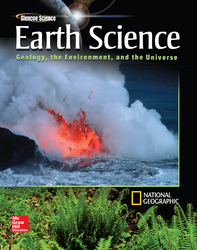1 A) ice and rock, the Sun B) helium gas, the Sun C) icy, each planet D) larger than Earth, Earth 2 A) zero, one B) nearly zero, one C) zero, nearly one D) one, zero 3 A) terrestrial, gas giant B) rocky, gas-like C) hard, soft D) gas giant, terrestrial 4 A) stars B) asteroids C) planetesimals D) solar nebula 5 <a onClick="window.open('/olcweb/cgi/pluginpop.cgi?it=gif::::/sites/dl/free/0078746361/561792/av.GIF','popWin', 'width=NaN,height=NaN,resizable,scrollbars');" href="#"><img valign="absmiddle" height="16" width="16" border="0" src="/olcweb/styles/shared/linkicons/image.gif"> (30.0K)</a> A) Venus B) Mars C) Mercury D) Earth 6 <a onClick="window.open('/olcweb/cgi/pluginpop.cgi?it=gif::::/sites/dl/free/0078746361/561792/av.GIF','popWin', 'width=NaN,height=NaN,resizable,scrollbars');" href="#"><img valign="absmiddle" height="16" width="16" border="0" src="/olcweb/styles/shared/linkicons/image.gif"> (30.0K)</a> A) Neptune B) Saturn C) Jupiter D) Uranus 7 A) iron and ice B) sulfuric acid C) hydrogen and helium D) rock and ice 8 A) how rare or common it is B) the distance to another planet C) the shape of its orbit D) the speed of its rotation 9 A) the vast oceans B) surfuric acid in its atmosphere C) the ammonia ice droplets D) the methane in its atmosphere 10 A) the law of universal gravitation B) Kepler's third law C) retrograde motion of planets D) telescopic observations of the planets 11 A) a scarp on Mercury B) a composite volcano on Venus C) a large shield volcano on Mars D) one of Mars' moons 12 A) 1 astronomical unit B) 1 mile C) 1 year D) 1 light year 13 A) an ellipse B) a line C) a sphere D) a circle 14 A) evidence of once living plants and animals B) dried river and lake beds C) minerals that precipitated from evaporating water D) the red color of the planet's surface 15 A) orbiting all planets B) between Mars and Jupiter C) outside of Pluto's orbit D) between Earth and Venus 16 A) Mercury, Venus, Mars B) Mercury, Io, Phoebe C) Venus, Mars, Jupiter, D) Jupiter, Saturn, Uranus 17 A) the Sun, Jupiter, Saturn, Uranus B) the Sun, Mercury, Venus, Saturn C) Mercury, Venus, Earth, Mars D) Jupiter, Saturn, Uranus, Pluto 18 A) The surface is covered by thick clouds. B) Venus has a high albedo. C) Venus has a clockwise spin. D) The surface is covered by thick ice sheets. 19 A) due to it's four moons B) its rings C) the Great Red Spot causes the bands D) flow patterns in its atmosphere 20 <a onClick="window.open('/olcweb/cgi/pluginpop.cgi?it=jpg::::/sites/dl/free/0078746361/561792/ge28_ctp_8.jpg','popWin', 'width=NaN,height=NaN,resizable,scrollbars');" href="#"><img valign="absmiddle" height="16" width="16" border="0" src="/olcweb/styles/shared/linkicons/image.gif"> (8.0K)</a> A) in the direction of the comet's orbit B) opposite the orbit direction C) toward the Sun D) away from the Sun 21 <a onClick="window.open('/olcweb/cgi/pluginpop.cgi?it=jpg::::/sites/dl/free/0078746361/561789/ge28_ctp_21.jpg','popWin', 'width=NaN,height=NaN,resizable,scrollbars');" href="#"><img valign="absmiddle" height="16" width="16" border="0" src="/olcweb/styles/shared/linkicons/image.gif"> (55.0K)</a> A) The Sun is the center of the universe. B) The shape of a planet's orbit is an ellipse. C) Planets move faster when they are closer to the Sun and slower when they are farther away. D) The speed of a planet's orbit steadily increases as it moves around the Sun. 22 A) nearly spherical in shape B) orbits the Sun C) is not a satellite D) has no debris within its orbit 23 A) asteroid belt B) Oort Cloud C) Kuiper Belt D) Outer zone





